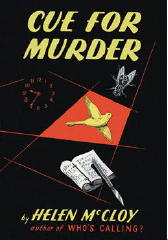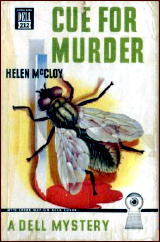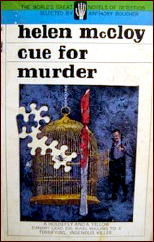Thu 12 Feb 2015
A 1001 Midnights Review: HELEN McCLOY – Cue for Murder.
Posted by Steve under 1001 Midnights , Authors , Reviews[12] Comments
by Robert E. Briney

HELEN McCLOY – Cue for Murder. William Morrow, hardcover, 1942. Reprint editions include: Dell #212, paperback, [1948], mapback edition; Bantam, paperback, 1965.
In his introduction to a reprint edition of Cue for Murder, Anthony Boucher recalled the reception of Helen McCloy’s first novel, Dance of Death (1938): “Few first mysteries have received such generous critical praise, as the reviewers stumbled over each other to proclaim [the author] a genuine find … combining a civilized comedy of manners with the strictest of logical deduction.”
In addition to an urbane and literate style, McCloy’s work is characterized by psychological insight, meticulous plotting, and the sheer ingenuity with which she handles seemingly impossible situations.

McCloy was one of the founding members of the Mystery Writers of America, and was that organization’s first woman president in 1950. She was married for fifteen years to mystery writer Davis Dresser, who, as Brett Halliday, created the popular private detective Michael Shayne. In addition to writing fiction, McCloy has been a publisher, editor, and literary agent. In 1953 she received an MWA Edgar for Mystery Criticism.
McCloy’s series detective, Dr. Basil Willing, was introduced in her first book; Cue for Murder is his fifth appearance. Willing is a psychiatrist, once a consultant to the Manhattan district attorney’s office and now, in the early months of World War II, working with the New York office of the FBI.
He is in the audience at the Royalty Theater on opening night of a modern-dress revival of Sardou`s Victorian melodrama Fedora. At the end of the first act, it is discovered that a murder has been committed on stage during the performance, but no one can identify the victim.

Willing is drawn into the investigation both throughm his police connections and through a family friendship with the production’s costume designer. The clues include a knife sharpener’s canary released from its cage, the odd behavior of a housefly, a mysterious figure on a fire escape, and a script containing an underlined cue for murder.
Cue for Murder is almost a textbook example of the classic fair-play detective novel, an intricate framework in which the clues fit together like the interlocking pieces of an elaborate jigsaw puzzle. The framework is fleshed out with diverting characters, acute psychological observation, a satiric and knowledgeable rendering of the theatrical background, and a vivid portrait of wartime Manhattan, complete with blackouts and air-raid wardens.
The book’s strength as a novel is measured by the fact that it can be read with pleasure even after its secrets are known.
———
Reprinted with permission from 1001 Midnights, edited by Bill Pronzini & Marcia Muller and published by The Battered Silicon Dispatch Box, 2007. Copyright © 1986, 2007 by the Pronzini-Muller Family Trust.
February 12th, 2015 at 11:47 pm
This is a book I’ve never read, and in fact posting this review makes me realize how much I’ve neglected Helen McCloy, almost completely. I’ve read only two books by her, and both were from the end of her career, neither particularly memorable.
Bob Briney makes this one sound like a real winner. He had good tastes in mysteries.
February 13th, 2015 at 1:20 am
This one gets reviewed a lot, but I think DANCE OF DEATH and THE DEADLY TRUTH are two of her best and both better than this one. The one thing I will credit this book with: it’s one of the finest examples of a theater mystery from this era. McCloy understands the minds of theater people so well and does a remarkable job of envisioning how a murderer in a theater setting might behave. She also replicates on page the workings of a real professional theater better than Ngaio Marsh who had a theatrical career prior to writing. The title of this book is also one of the rare instances of being a pertinent clue to help the reader in solving the mystery.
February 13th, 2015 at 5:15 am
Just added a link to the above review to my McCloy article:
http://mikegrost.com/mccloy.htm
My article has now reached 85 pages.
February 13th, 2015 at 10:46 am
Mike,
Another 15 pages and you’ll hit 100!
February 13th, 2015 at 10:50 am
I don’t think I’ve ever read any of her books. I’ll have to see if I have any — not that I’ll ever find time to read them.
February 13th, 2015 at 1:56 pm
Genteel books about sophisticated theater types like “Cue for Murder” is only one strand in McCloy.
She also wrote some mildly tough, medium-boiled mysteries like “The Goblin Market”, set on a Caribbean island. They might anticipate the sort of mysteries by Muller and Pronzini write, which combine medium toughness with complex mystery plotting.
This sort of book might have more initial appeal to some Mystery*File readers, who like medium-boiled fiction.
February 13th, 2015 at 2:38 pm
If you like a touch of the supernatural as in Carr’s THE BURNING COURT, find the Willing novel THROUGH A GLASS DARKLY which is one of the best, if not the best, examples of the Janus solution (the ordinary and the supernatural explanation have equal weight and it is left up to the reader). Her later Willing novel MR. SPLITFOOT isn’t quite as good, but it’s close.
She is always literate, and as the review says there is no diminishment of the pleasures of her work once you know the solution.
She appears in, and Brett Halliday (Dresser) narrates, one of the Michael Shayne anniversary novels involving murder at the MWA convention, I’m not sure if it’s MICHAEL SHAYNE’S 50th CASE or another.
Ironically THE GOBLIN MARKET Mike mentions is also a Willing novel. She managed to use him as a detective hero in different ways making him one of the most adaptable sleuths without real personality change in the literature.
February 14th, 2015 at 10:39 am
The Mike Shayne novel set at an MWA dinner is SHE WOKE TO DARKNESS (1954).
The few Basil Willing novels I’ve read all had suggestions of the supernatural, like poltergeists, always explained away at the end. The only novelty about THROUGH A GLASS DARKLY is that the killer, although copping to some of the villainy, refuses to confess to the murder. I don’t agree that this rises to the level of the supernatural solution having equal weight, as it does in THE BURNING COURT.
February 14th, 2015 at 7:36 pm
Ken,
Thanks for the Shayne title. I remembered the book and not the title.
Re DARKLY, you are right that it does not give equal weight to the supernatural, nor is it the tour de force COURT is, but then Carr’s book almost doesn’t fit the Janus category because the supernatural turns out to be the actual solution with no question in the readers mind. In DARKLY it is left open to the reader whether the supernatural was involved or not making it the perfect example of the Janus solution where ambiguity is the point.
September 6th, 2016 at 4:56 pm
I am a great fan of McCloy, and I think this is one of her better works. Through a Glass Darkly gets a lot of acclaim and is quite good, however for a pure detective piece Cue for Murder, The Deadly Truth, and Dance for Death are all excellent examples. I have also enjoyed her thriller-style books like She Walks Alone, Do Not Disturb, and Goblin’s Market (which is probably my favorite).
December 11th, 2021 at 3:01 pm
[…] for Murder has been reviewed, among others, by Noah Stewart at Noah’s Archives, Robert E. Briney at Mystery File, Moira Redmond at Clothes in Books, Les Blatt at Classic Mysteries, Steve Lewis at Mystery File, […]
December 12th, 2021 at 5:20 am
[…] In his introduction to a reprint edition of Cue for Murder, Anthony Boucher recalled the reception of Helen McCloy’s first novel, Dance of Death (1938): “Few first mysteries have received such generous critical praise, as the reviewers stumbled over each other to proclaim [the author] a genuine find … combining a civilized comedy of manners with the strictest of logical deduction.†(Mystery File) […]